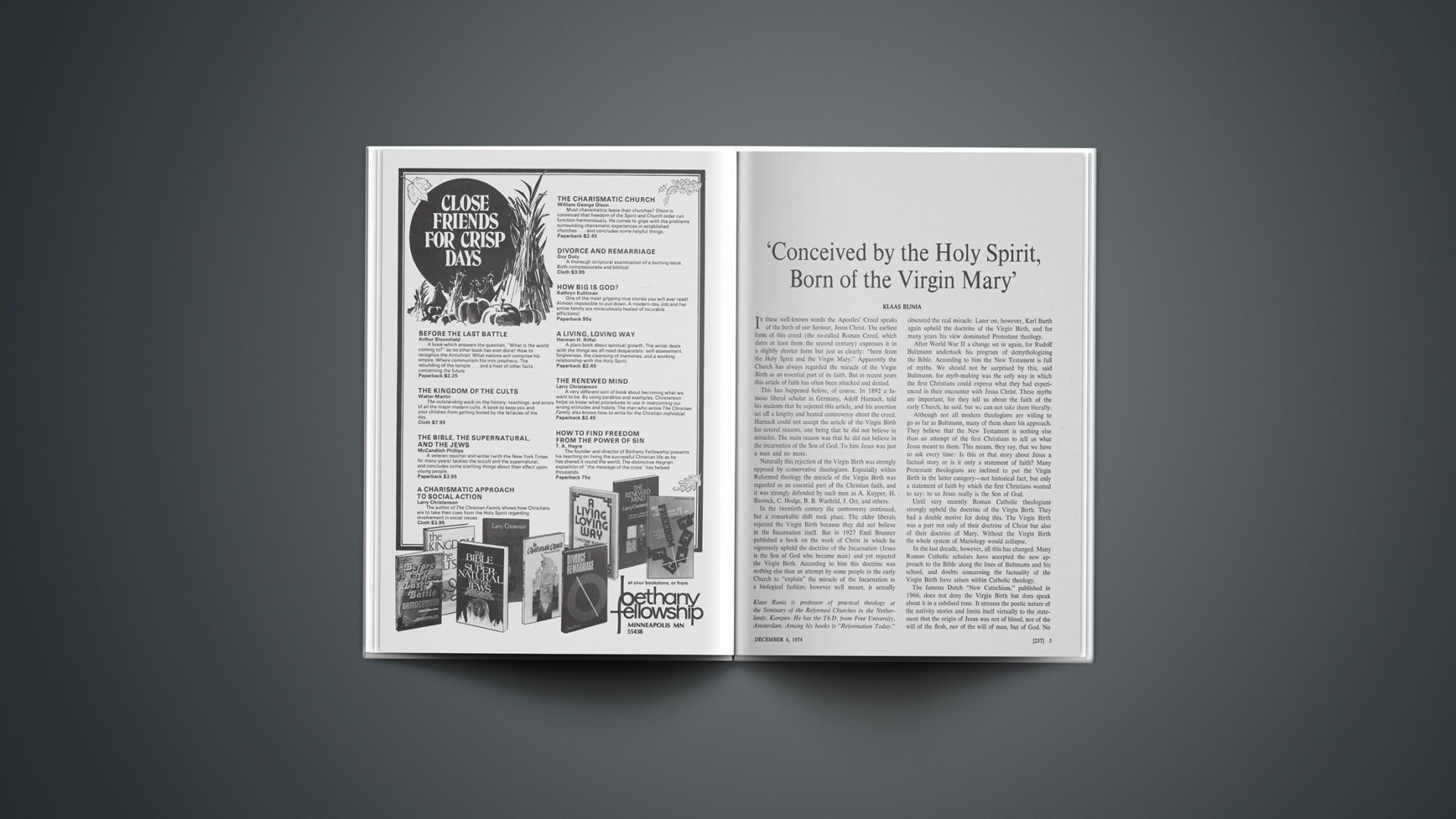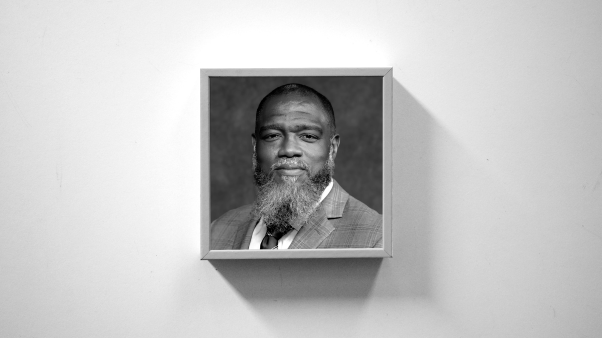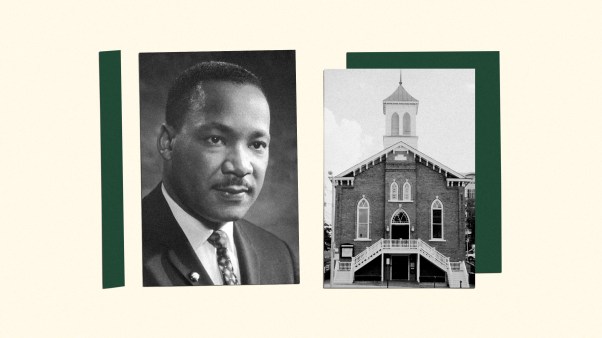In these well-known words the Apostles’ Creed speaks of the birth of our Saviour, Jesus Christ. The earliest form of this creed (the so-called Roman Creed, which dates at least from the second century) expresses it in a slightly shorter form but just as clearly: “born from the Holy Spirit and the Virgin Mary.” Apparently the Church has always regarded the miracle of the Virgin Birth as an essential part of its faith. But in recent years this article of faith has often been attacked and denied.
This has happened before, of course. In 1892 a famous liberal scholar in Germany, Adolf Harnack, told his students that he rejected this article, and his assertion set off a lengthy and heated controversy about the creed. Harnack could not accept the article of the Virgin Birth for several reasons, one being that he did not believe in miracles. The main reason was that he did not believe in the incarnation of the Son of God. To him Jesus was just a man and no more.
Naturally this rejection of the Virgin Birth was strongly opposed by conservative theologians. Especially within Reformed theology the miracle of the Virgin Birth was regarded as an essential part of the Christian faith, and it was strongly defended by such men as A. Kuyper, H. Bavinck, C. Hodge, B. B. Warfield, J. Orr, and others.
In the twentieth century the controversy continued, but a remarkable shift took place. The older liberals rejected the Virgin Birth because they did not believe in the Incarnation itself. But in 1927 Emil Brunner published a book on the work of Christ in which he vigorously upheld the doctrine of the Incarnation (Jesus is the Son of God who became man) and yet rejected the Virgin Birth. According to him this doctrine was nothing else than an attempt by some people in the early Church to “explain” the miracle of the Incarnation in a biological fashion; however well meant, it actually obscured the real miracle. Later on, however, Karl Barth again upheld the doctrine of the Virgin Birth, and for many years his view dominated Protestant theology.
After World War II a change set in again, for Rudolf Bultmann undertook his program of demythologizing the Bible. According to him the New Testament is full of myths. We should not be surprised by this, said Bultmann, for myth-making was the only way in which the first Christians could express what they had experienced in their encounter with Jesus Christ. These myths are important, for they tell us about the faith of the early Church, he said, but we can not take them literally.
Although not all modern theologians are willing to go as far as Bultmann, many of them share his approach. They believe that the New Testament is nothing else than an attempt of the first Christians to tell us what Jesus meant to them. This means, they say, that we have to ask every time: Is this or that story about Jesus a factual story or is it only a statement of faith? Many Protestant theologians are inclined to put the Virgin Birth in the latter category—not historical fact, but only a statement of faith by which the first Christians wanted to say: to us Jesus really is the Son of God.
Until very recently Roman Catholic theologians strongly upheld the doctrine of the Virgin Birth. They had a double motive for doing this. The Virgin Birth was a part not only of their doctrine of Christ but also of their doctrine of Mary. Without the Virgin Birth the whole system of Mariology would collapse.
In the last decade, however, all this has changed. Many Roman Catholic scholars have accepted the new approach to the Bible along the lines of Bultmann and his school, and doubts concerning the factuality of the Virgin Birth have arisen within Catholic theology.
The famous Dutch “New Catechism,” published in 1966, does not deny the Virgin Birth but does speak about it in a subdued tone. It stresses the poetic nature of the nativity stories and limits itself virtually to the statement that the origin of Jesus was not of blood, nor of the will of the flesh, nor of the will of man, but of God. No wonder that this part of the catechism was severely criticized by the commission appointed by the Pope.
In the meantime, however, individual scholars, both exegetical and systematic theologians, went much further. In a very recent German publication (A New Book of Faith) a Roman Catholic theologian frankly states that the story of the Virgin Birth does not belong to the earliest Christian tradition but appears rather late in the Gospels of Matthew and Luke, both of which were written after 70 A.D. It is therefore an open question whether it is a fact or only a “teaching story” intended to tell us about the great significance of Jesus the Messiah. Other Catholic theologians have gone further and have made their choice: it is not a fact but only a “teaching story” or “teaching model.”
One cannot help wondering why this part of the creed has been subjected to so much criticism. What are the grounds for this critical attitude? Recent writing on the matter reveals several lines of argument.
Many theologians approach the matter from an exegetical angle. They point to the fact that this miracle is mentioned only by Matthew and Luke, and is absent in the rest of the New Testament. Of particular importance is its absence in the letters of Paul, which are the earliest documents we have. Therefore it must be a later addition. They further point to the peculiar nature of all the stories about Jesus’ birth. According to them it is obvious that they are “poetic” or even “legendary” and not “factual.” The evangelists wanted to “proclaim” or “preach” the greatness and uniqueness of Jesus in the form of stories. Most likely, Isaiah 7:14 (the prophecy that Immanuel will be born of a “virgin”) has been the origin of these beautiful stories, they say.
Other theologians approach the matter from a dogmatical angle. They believe that the Virgin Birth, if taken literally, actually takes away from the Incarnation. If the Son of God really became “man” he must have become man through a normal human birth. Otherwise his humanity is not full and true.
None of these exegetical arguments can bear close scrutiny. It is true that the Virgin Birth is mentioned only by Matthew and Luke. But what does this prove? Is it therefore any less true? It is quite obvious that Matthew and Luke each had a source of information; their accounts are so different that it is hard to assume they originated from the same source. This means that the Virgin Birth must have belonged to the common tradition of the early Church. Moreover, Matthew introduces it in such a casual way that one can only conclude it must have been well known to his readers. It is also against the evidence to say that Isaiah 7:14 was the origin of the story. Luke does not even mention this text!
The silence of Paul is no proof either. Quite apart from the fact that some scholars do find a reference to it in Galatians 4:4 (“born of a woman”) we should never forget that Paul’s letters were all “occasional” letters. None of them was intended to give a complete statement of the Christian faith; each was written because there was some special reason for a letter to a certain congregation. In most cases this reason was that the congregation was threatened by some heresy or false doctrine, and it is natural that in such a case the apostle mentioned only those matters that were relevant to the situation.
The dogmatical arguments are hardly more convincing. Why should the Lord be any less human if he was born of Mary only, without any cooperation of Joseph? The New Testament nowhere suggests that Jesus is half divine and half human because he was conceived by the power of the Spirit and born of Mary. There is no suggestion whatever of the Holy Spirit’s playing the role of the husband of Mary. On the contrary, Luke very carefully records the words spoken by the angel Gabriel: “The Holy Spirit will come upon you and the power of the Most High will overshadow you” (Luke 1:34). These words point to the miracle without explaining it. The power of God the Holy Spirit accomplishes the miracle, and he does it by “overshadowing” Mary, a term that reminds us of the cloud overshadowing the Tabernacle.
Why indeed should the Son of God need two parents in order to be fully human? Both the Gospel of Matthew and the Gospel of Luke show us how truly human the Lord was. He lived a fully human life, in no way different from that of other people, except that he did not sin. What is more, he suffered and died. He was not “God dressed up as a man” (as Bishop Robinson once said in Honest to God), but it is as the Letter to the Hebrews says: “Since therefore the children share in flesh and blood, he himself likewise partook of the same nature, that through death he might destroy him who has the power of death, that is, the devil” (Heb. 2:14). And a little further on the same author speaks of him as having suffered and having been tempted (2:18). “Although he was the Son, he learned obedience through what he suffered” (5:8).
There is therefore not sufficient reason, either exegetical or dogmatical, for doubting the miracle of the Virgin Birth. We must even go further and say that this miracle fully fits in with the rest of Scripture. Throughout the whole New Testament we read that Jesus as the Messiah is the great gift of God. He is not the top of humanity reaching out to God, but in him God is stooping down to a mankind lost in sin and guilt. Time and again the New Testament emphasizes that God gave his Son to the world or sent his Son into the world. His coming is wholly God’s initiative. It is therefore not surprising to see that man, the active partner in the marriage act, is eliminated. Only the woman, the receiving partner, is used by God. And in this particular case God uses a young girl who is a virgin, Mary of Nazareth. She is only used by God. She does not, as traditional Roman Catholic theology wants us to believe, cooperate with God. She is just an instrument in God’s hand. She is only the one who is privileged, elected to be overshadowed by the Holy Spirit and thus to give birth to the Son of God in the flesh.
All this does not mean that now we understand the miracle of the Incarnation. It remains a mystery. But for one who believes that Jesus is the Son of God in the flesh, this miracle is an added reason to say: “O God, how wonderful are your ways!” Such a person finds it is not “hard” to believe this miracle, not because he is credulous anyway, but because he believes the miracle of all miracles, the miracle of the Incarnation itself: the Word of God becoming flesh, the Son of God becoming man. Therefore he bows his head in amazement before God’s wondrous ways and says: “How fitting that he was ‘conceived by the Holy Spirit and born of the Virgin Mary.’ ” He believes both that this miracle happened and also that it is a miracle full of salvation.
This, in fact, is the way in which the Church of all ages has understood the Virgin Birth. This was the reason why the ancient Church inserted it in the Apostles’ Creed. It was not just a miraculous fact but a saving fact. It was part and parcel of the whole miracle of salvation, for in this miraculous way the eternal Son of God became one of us, in order to redeem us through his death on the cross. This saving aspect is beautifully formulated in the Heidelberg Catechism, when, in answer to the question “What benefit do you receive from the holy conception and birth of Christ?,” it first says: “That he is our Mediator.” That is the main content of the miracle. And then, as additional riches, the catechism says: “That with his innocence and perfect holiness he covers, in the sight of God, my sin wherein I was conceived and brought forth.”










